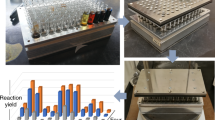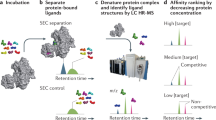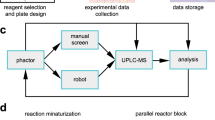Abstract
The potential of protein microarrays1 in high-throughput screening (HTS) still remains largely unfulfilled, essentially because of the difficulty of extracting meaningful, quantitative data from such experiments2,3. In the particular case of enzyme microarrays3, low-molecular-weight fluorescent affinity labels4,5,6,7,8,9,10 (FALs) can function as ideally suited activity probes of the microarrayed enzymes. FALs form covalent bonds with enzymes in an activity-dependent manner and therefore can be used to characterize enzyme activity at each enzyme's address, as predetermined by the microarraying process11. Relying on this principle3, we introduce herein thematic enzyme microarrays (TEMA). In a kinetic setup we used TEMAs to determine the full set of kinetic constants and the reaction mechanism between the microarrayed enzymes (the theme of the microarray) and a family-wide FAL. Based on this kinetic understanding, in an HTS setup we established the practical and theoretical methodology for quantitative, multiplexed determination of the inhibition profile of compounds from a chemical library against each microarrayed enzyme. Finally, in a validation setup, Kiapp values and inhibitor profiles were confirmed and refined.
This is a preview of subscription content, access via your institution
Access options
Subscribe to this journal
Receive 12 print issues and online access
$209.00 per year
only $17.42 per issue
Buy this article
- Purchase on Springer Link
- Instant access to full article PDF
Prices may be subject to local taxes which are calculated during checkout




Similar content being viewed by others
References
Kambhampati, D. (ed.). Protein microarray technology (Wiley-VCH, Heidelberg, 2004).
Zhu, H. et al. Global analysis of protein activities using proteome chips. Science 293, 2101–2105 (2001).
Eppinger, J., Funeriu, D.P., Miyake, M., Denizot, L. & Miyake, J. Enzyme microarrays: on-chip determination of inhibition constants based on affinity-label detection of enzymatic activity. Angew. Chem. Int. Ed. 43, 3806–3810 (2004).
Chen, G.Y., Uttamchandani, M., Zhu, Q., Wang, G. & Yao, S.Q. Developing a strategy for activity-based detection of enzymes in a protein microarray. ChemBioChem 4, 336–339 (2003).
Liu, Y., Patricelli, M.P. & Cravatt, B.F. Activity-based protein profiling: the serine hydrolases. Proc. Natl. Acad. Sci. USA 96, 14694–14699 (1999).
Campbell, D.A. & Szardenings, A.K. Functional profiling of the proteome with affinity labels. Curr. Opin. Chem. Biol. 7, 296–303 (2003).
Speers, A.E. & Cravatt, B.F. Profiling enzyme activities in vivo using click chemistry methods. Chem. Biol. 5, 535–546 (2004).
Greenbaum, D.C. et al. Small molecule affinity fingerprinting. A tool for enzyme family subclassification, target identification, and inhibitor design. Chem. Biol. 9, 1085–1094 (2002).
Jessani, N. & Cravatt, B.F. The development and application of methods for activity-based protein profiling. Curr. Opin. Chem. Biol. 8, 54–59 (2004).
Goulet, B. et al. A cathepsin L isoform that is devoid of a signal peptide localizes to the nucleus in S phase and processes the CDP/Cux transcription factor. Mol. Cell 14, 207–219 (2004).
Gosalia, D.N. & Diamond, S.L. Printing chemical libraries on microarrays for fluid phase nanoliter reactions. Proc. Natl. Acad. Sci. USA 100, 8721–8726 (2003).
Berdowska, I. Cysteine proteases as disease markers. Clin. Chim. Acta 342, 41–69 (2004).
Greenbaum, D.C. et al. A role for the protease falcipain 1 in host cell invasion by the human malaria parasite. Science 298, 2002–2006 (2002).
Lecaille, F., Kaleta, J. & Brömme, D. Human and parasitic papain-like cysteine proteases: their role in physiology and pathology and recent developments in inhibitor design. Chem. Rev. 102, 4459–4488 (2002).
Kang, K. & Kim, W. Recent developments of cathepsin inhibitors and their selectivity. Exp. Opin. Therap. Pat. 12, 419–432 (2002).
Powers, J.C., Asgian, J.L., Ekici, Ö.D. & James, K.E. Irreversible inhibitors of serine, cysteine, and threonine proteases. Chem. Rev. 102, 4639–4750 (2002).
Otto, H.-H. & Schirmeister, T. Cysteine proteases and their inhibitors. Chem. Rev. 97, 133–171 (1997).
Kuzmic, P. Program DYNAFIT for the analysis of enzyme kinetic data: application to HIV proteinase. Anal. Biochem. 237, 260–273 (1996).
Carrillo, A., Gujraty, K.V. & Kane, R.S. Surfaces and substrates. in Microarray Technology and Its Applications (eds. Mueller, U.R. & Nicolau, D.V.) 45–61 (Springer GmbH, Berlin, 2005).
Kuzmic, P. et al. High-throughput screening of enzyme inhibitors: automatic determination of tight-binding inhibition constants. Anal. Biochem. 281, 62–67 (2000).
Leung, D., Hardouin, C., Boger, D.L. & Cravatt, B.F. Discovering potent and selective reversible inhibitors of enzymes in complex proteomes. Nat. Biotechnol. 21, 687–691 (2003).
Sasaki, T. et al. Inhibitory effect of di- and tripeptidyl aldehydes on calpains and cathepsins. J. Enzyme Inhib. 3, 195–201 (1990).
Yamashita, D.S. et al. Structure and design of potent and selective cathepsin K inhibitors. J. Am. Chem. Soc. 119, 11351–11352 (1997).
Rydzewski, R.M. et al. Peptidic 1-cyanopyrrolidines: synthesis and SAR of a series of potent, selective cathepsin inhibitors. Bioorg. Med. Chem. 10, 3277–3284 (2002).
Kirschke, H., Barrett, A.J. & Rawlings, N.D. Proteinases 1: lysosomal cysteine proteases. Protein Profile 2, 1581–1643 (1995).
Gilbert, B.A. & Rando, R.R. Modular design of biotinylated photoaffinity probes: synthesis and utilization of a biotinylated pepstatin photoprobe. J. Am. Chem. Soc. 117, 8061–8066 (1995).
Hagenstein, M.C. et al. Affinity-based tagging of protein families with reversible inhibitors: a concept for functional proteomics. Angew. Chem. Int. Ed. 42, 5635–5638 (2003).
Saghatelian, A., Jessani, N., Joseph, A., Humphrey, M. & Cravatt, B.F. Activity-based probes for the proteomic profiling of metalloproteases. Proc. Natl. Acad. Sci. USA 101, 10000–10005 (2004).
Acknowledgements
We thank Robert Menard for providing recombinant cathepsin B and recombinant cathepsin L. This work was supported by the National Institute of Advanced Industrial Science and Technology of Japan and by the Stifterverband für die Deutsche Wissenschaft (Projekt-Nr. 11047: ForschungsDozentur Molekulare Katalyse).
Author information
Authors and Affiliations
Corresponding authors
Ethics declarations
Competing interests
The authors are currently involved in the founding process of the biotechnology company Alceis Sarl., which might, among others, use the technology described in the article.
Supplementary information
Supplementary Fig. 1
Full kinetic modelling for Cathepsin B bovine (PDF 59 kb)
Supplementary Fig. 2
Full kinetic modelling for Cathepsin B, human (PDF 57 kb)
Supplementary Fig. 3
Full kinetic modelling for Cathepsin B, recombinant (PDF 55 kb)
Supplementary Fig. 4
Full kinetic modelling of Cathepsin C (PDF 56 kb)
Supplementary Fig. 5
Full kinetic modelling of Cathepsin H (PDF 58 kb)
Supplementary Fig. 6
Full kinetic modelling of Cathepsin K (PDF 56 kb)
Supplementary Fig. 7
Full kinetic modelling of Cathepsin L (PDF 57 kb)
Supplementary Fig. 8
Full kinetic modelling of Cathepsin S (PDF 56 kb)
Supplementary Fig. 9
Results of the influence of surfactant (SDS) and pH on the microarrayed enzyme's activity. (PDF 495 kb)
Supplementary Table 1
On-chip kinetic constants for the reaction between cathepsins and the FAL 1. (PDF 35 kb)
Supplementary Table 2
Literature values of inhibition constants of different cathepsins for the known inhibitors screened in the HTS setup. (PDF 41 kb)
Supplementary Table 3
Kiapp/nM values for different cathepsins, determined in evaluation experiment (PDF 27 kb)
Rights and permissions
About this article
Cite this article
Funeriu, D., Eppinger, J., Denizot, L. et al. Enzyme family–specific and activity-based screening of chemical libraries using enzyme microarrays. Nat Biotechnol 23, 622–627 (2005). https://doi.org/10.1038/nbt1090
Received:
Accepted:
Published:
Issue Date:
DOI: https://doi.org/10.1038/nbt1090
This article is cited by
-
Protein arrays for quantitative enzymatic profiling and serodiagnosis
BioChip Journal (2015)
-
High Throughput Enzyme Inhibitor Screening by Functionalized Magnetic Carbonaceous Microspheres and Graphene Oxide-Based MALDI-TOF-MS
Journal of the American Society for Mass Spectrometry (2011)
-
Automated analytical microarrays: a critical review
Analytical and Bioanalytical Chemistry (2008)
-
Activity-based proteomics: enzymatic activity profiling in complex proteomes
Amino Acids (2006)
-
Modification of small molecules by using cytochrome P450 expressed in Escherichia coli
Journal of Industrial Microbiology & Biotechnology (2006)



